We left the house shortly after 8:15 am. We stopped for breakfast at Fidel's Cafe on Cuba St.... strawberry muffin with cream, a date scone, and spinach and cheese roll with great chutney sauce (all warmed). It was raining heavily as we headed out of town. The car started to smell like it was overheating (even though the gauges showed nothing), so we pulled over and popped the hood. Everything looked fine. Our suspicion was that it was the defroster. So we turned it off, had foggy windows, and were fine after that.

They just melted in your mouth!

Incredibly good!
The road through the mountains greeted us with more rain and thick fog. About an hour later, we pulled into Greytown. We stopped into the tourist office for directions and info on Stonehenge Aotearoa (Aotearoa is the Maori name for New Zealand). Regan had signed us up for the 10 am tour, but we weren't exactly sure how to get there.
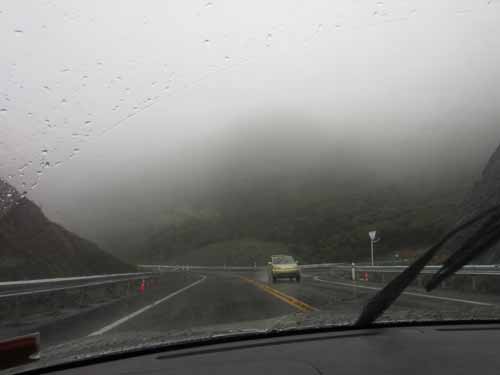
We followed the directions through Carterton and soon found ourselves out in the country. We pulled up about one minute late. We were informed that another group had just cancelled because of the rain, so they weren't sure if we were going to show or now.
We walked into the next room that was set up with many chairs and a movie screen. We first got a wonderful history of the stars from Richard, our guide and one of the builders of this place. We then got to a watch a movie showing the stonehenge in action.
Growing up in a city, it was hard to understand how life-and-death important the stars were to our ancestors, both while at home and traveling. They were giant markers that predicted change... of the seasons and the weather, of animal migrations, of the phases of the crops, etc.
The names of the stars have been kept even if many of their stories have been lost. Sirius is also called the Dog star. This goes back to ancient Egypt, even before the dawn of agriculture, when nomadic tribes moved around their flocks. They used dogs to help warn them of danger. Well, when Sirius appeared in the sky, it warned the shepherds that the Nile was about to do its seasonal flood, so it was time to move their animals to higher ground. Hence it became the dog star, warning them of danger.
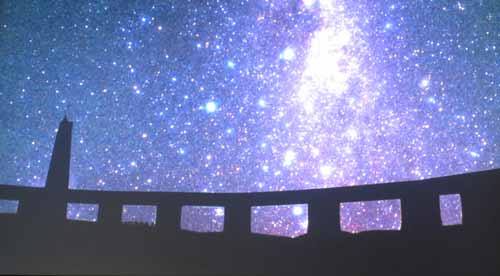
Scene from the movie: the night sky we don't see in the cities with the fabulous Milky Way
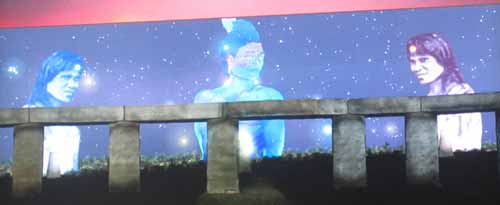
The Maori also had their stories associated with the sun and the stars. They believed that the sun god, Tama-nui-te-ra, had two wives: Hine-Raumati (the summer maid associated with Antares) and Hine-Takurua (the winter maid associated with Sirius). He travels back and forth between them. This is the pattern that the sun makes in the sky over the course of a year.
For centuries, people all over the world have been building stonehenges to help them track the stars. Originally they were made out of timber. Although similar in size and appearance, Stonehenge Aotearoa is not just an exact copy of the famous one on Salisbury plain in England. It is designed to be functioning for the Southern hemisphere. We grabbed our umbrellas and walked out to see it in the flesh... uh... stone.
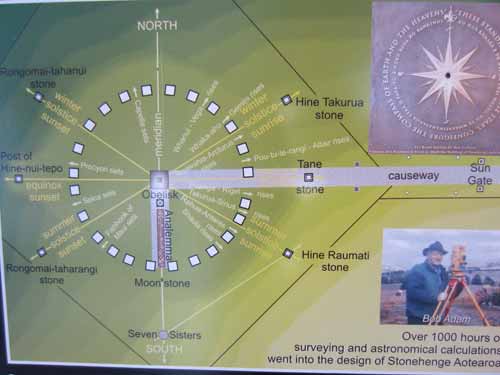
Built in 2005, the structure has a 30 meter diameter (around 98 feet) and contains 24 pillars (capped with lintels) and 6 stone heels (which mark important mark celestial points).
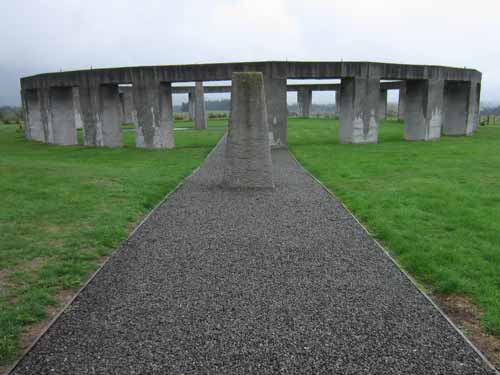
The "causeway" is the road that leads into the circle. It is aligned perfectly east/west. While it is obvious as to where the west end goes (into the stonehenge), the east end seems to go to nowhere. That is only because this road is built for the gods, not us humans. It actually goes to a gate that leads between realms. It was believed that that these gates would open at only certain times of year (on the equinoxes and the solstices), at which time the immortals could cross between heaven, earth and the underworld.
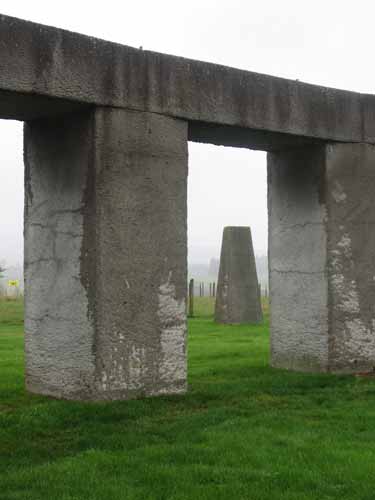
The heel stones mark important points in the sun's travels across the sky. Each one is of a different height, but when standing in the center of the circle, they each appear to touch the horizon.
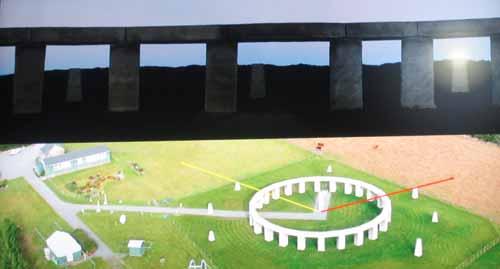
This scene from the movie shows the setting sun at the top of one of the heel stones marking a solstice, which is the furthest north or south the sun will travel. After it hits that point, it will start back in the other direction until it reaches the heel stone on the other side. Two other stones mark the equinoxes, when the sun sets due east and west.

If you look carefully, you'll see the distances between the pillars are not even. This is done as to not block some of important stars in the Polynesian stories.
The lintels are used to create a flat horizon, giving the illusion of being under a giant dome. In other stonehenges, it is believed that the lintels were colorfully painted, depicting the star events that would take place at that spot. Time has removed all traces of this, just like with the Gothic churches of Europe. They weren't just the dull, lifeless stone we see today but were at one time radiant and colorful.
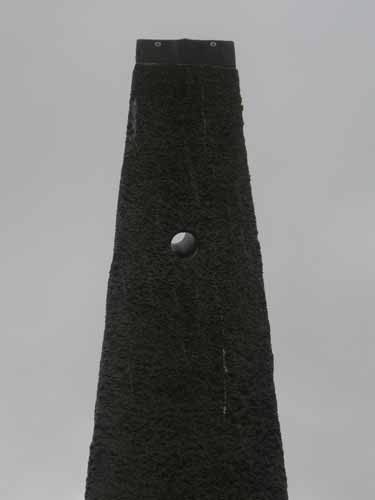
When one stands in the center of the circle and looks directly up through this hole in the 5 meter tall (around 16 1/2 feet) obelisk, you can find the location of the south celestial pole (the point around which the entire heaves appears to revolve).
Unlike the Northern hemisphere which has Polaris (the North Star), the southern hemisphere doesn't have anything similar. This is why the Southern Cross is so important, since it could be used by navigators to find it.
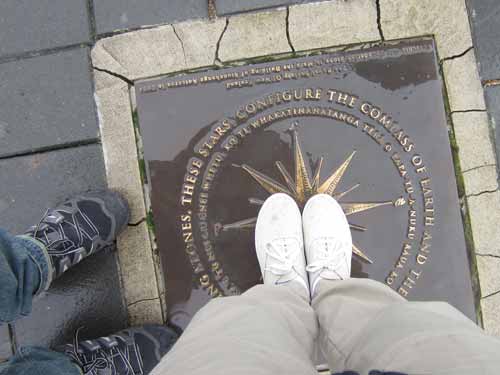
The center of the henge
Next came the Analemma, which serves as a clock and calendar. It runs directly north/south. It was quite difficult absorbing all the complex information, but here's the best as I understood it (which could be VERY wrong as I'm not even a novice astronomer).
The yellow line is a calendar. It marks the position of the midday sun over the course of a year. Not only does it vary north and south (the higher or lower altitude in the sky), it also varies east and west. This is because the earth has an elliptic course around the sun.
The Roman numerals on the yellow line represent the months (1 = January, 2 = February, etc). The small arrows are for the 1st, 8th, 16th and 23rd of each months. They are different distances apart because the sun travels faster in the middle and slower on the ends of the path. The Maori explain it as the sun is in a hurry to get to each wife, but then takes his time when he is with her.
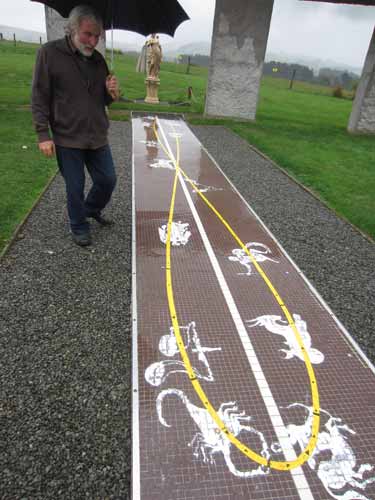
The white line represents the north-south meridian. Where the white and yellow lines cross are the solstices and equinoxes, the only times of year when a day (a solar day as measured by a sundial) is exactly 24 hours... the rest of the time, it is either longer or shorter (which is shown by which side of the meridian, or white line, it is on (again due to the earth's axis and elliptical orbit).
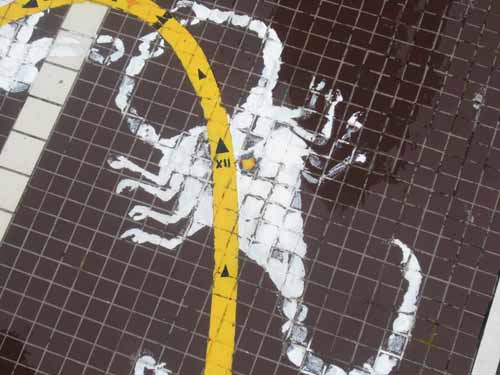
The scorpion, with the red star of Antares, is Hine-Raumati (the summer maid). The date closest to the yellow dot reads XII (or December) 16th. Remember that December down here is the peak of summer.
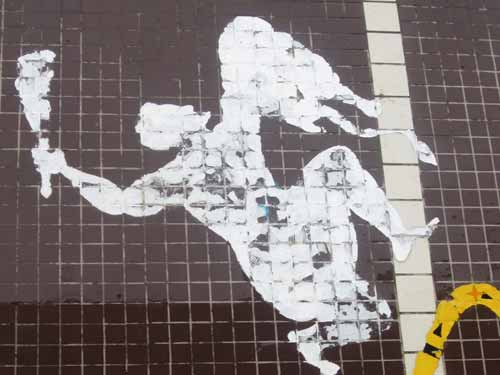
At the far other end is the constellation of Orion, which is associated with the blue star of Sirius and Hine-Takurua (the winter maid).
Orion is not in the zodiac but probably should be. The story goes that he was a great hunter, but very boastful. One day he was sitting with the male gods and, in a drunken stupor, claimed he could kill every animal. Artemis (also known as Diana, goddess of the hunt) overheard him and didn't want him killing all HER animals. So she send a giant scorpion to kill him. It tore its way through the Milky way, leaving a large black rift (which we now know is caused by dark gas blocking out the stars behind it). It was a tremendous fight but the scorpion finally prevailed and killed Orion. This upset the male gods immensely, so the brought him up from the underworld to the sky and made him immortal. In her continued rage, Artemis then gave the scorpion immortality too and made it chase Orion across the heavens. This is the story of the seasons in the Southern hemisphere. When Orion peeks over the horizon and doesn't see the scorpion, he feels free to come out and wander about the sky and it starts to become summer. When he sees the scorpion coming up behind him, he disappears again and the scorpion searches the sky for him and it starts to become winter. When they can both be seen, it is the equinoxes.
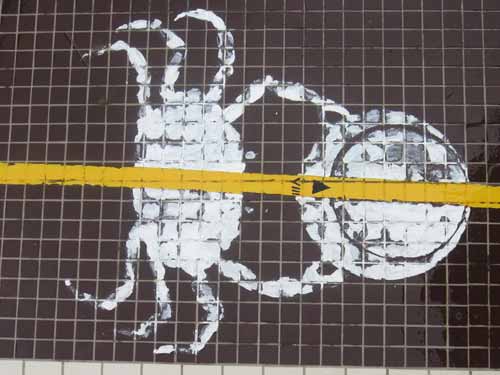
This is my zodiac sign... Cancer... or is it??
First off, the constellations are named after their symbolism not for their shape. Aquarius marks the start of the rainy season, hence depicted as a god pouring water. Leo was the hottest time of yea, when the lions would come to hunt the flocks. Cancer was when the crabs from the Nile River came up on land. And so on.
As the sun moves across the time throughout the year, it passes against a background of different stars, or the different constellations that make up the zodiac. But as with all things in the heavens, it shifts with time... not the kind of time that you or I might notice in a lifetime, but definitely significant over thousands of years. The "precession of the equinoxes" causes the zodiacs signs to move one day every 71 years. Eventually they will get back to their original positions... after some 25,700 years or so.
In the 1300's, however, the pope issued a decree banning alchemy, with which astrology was associated. In 1910, it was agreed astrology could return but ONLY if charts were used from the Holy Roman Empire... from a good 2,000 years ago. Needless to say they were outdated.
So what does that mean to me? Well, if I had been born 2,000 years ago, the sun would have been in the constellation of Cancer. But born when I was, the skies had shifted and I was born as a Taurus/Gemini.
Here's a table of the real zodiac for today:
Capricorn - Jan 20 to Feb 16
Aquarius - Feb 16 to Mar 11
Pisces - Mar 11 to Apr 18
Aries - Apr 18 to May 13
Taurus - May 13 to Jun 21
Gemini - Jun 21 to Jul 20
Cancer - Jul 20 to Aug 10
Leo - Aug 10 to Sep 16
Virgo - Sep 16 to Oct 30
Libra - Oct 30 to Nov 23
Scorpius - Nov 23 to Nov 29
Ophiuchus - Nov 29 to Dec 17
Sagittarius - Dec 17 to Jan 20
However, do not despair... if you REALLY want to remain the sign you thought you were born with, there is still hope. There is also something called the tropical zodiac which is fixed to seasons (more traditional in the western cultures), which differs from the sidereal zodiac, which is fixed to the constellations (more common for eastern cultures).
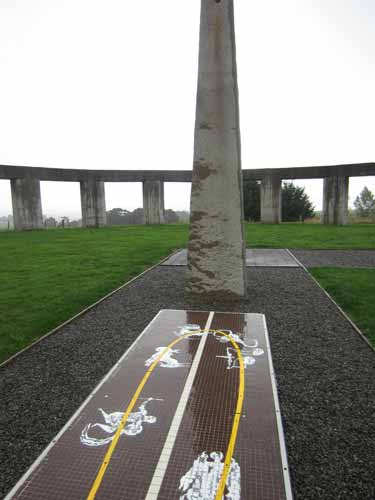
During sunny days, the obelisk serves as a sundial. Each day has different shadow length.
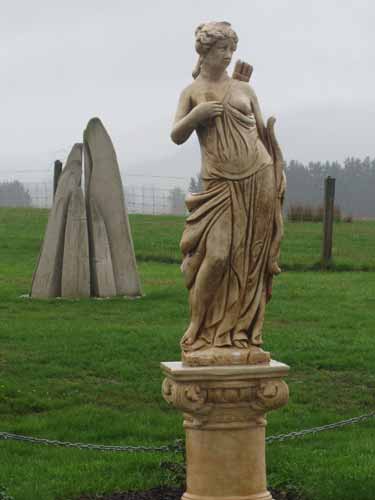
Behind the statue of Artemis are seven stones representing the Seven Sisters, or Pleiades. Thousands of years ago the rising of these stars marked the beginning of the year for many cultures. It was also the mark of spring and the return of food.
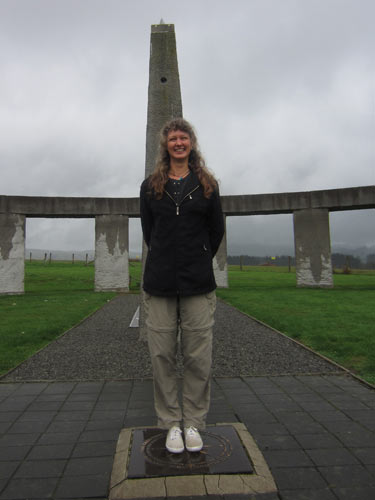
Standing in the center of a stone circle, where the high priestesses and oracles once stood. I can now add this to my collection of famous center spots, including the omphalos in Delphi (the navel of the world) and the the center of the universe in the Temple of Heaven, Beijing.
As a departing story, Richard talked about the incredible acoustic properties of the stone circle. Depending on where one stands, one can hear absolutely everything said (such as from the center of the circle) to nothing (outside the circle). They've had lots of music, chanting, and drum performances here. The sounds bounces back and forth between the stone pillars, amplifying and resonating it. From his own personal experience, this can induce a type of hypnotic trance through altering the brain waves. He said they even experienced animal summoning during one druid chanting session, as the cows and bulls and horses all came up to the circle from the surrounding fields and started acting very strangely.
We returned to the warm indoors and thanked him profusely. The tour had lasted almost 2 hours! And that was just with the stonehenge. He had said they were currently in the process of adding many many more things.

